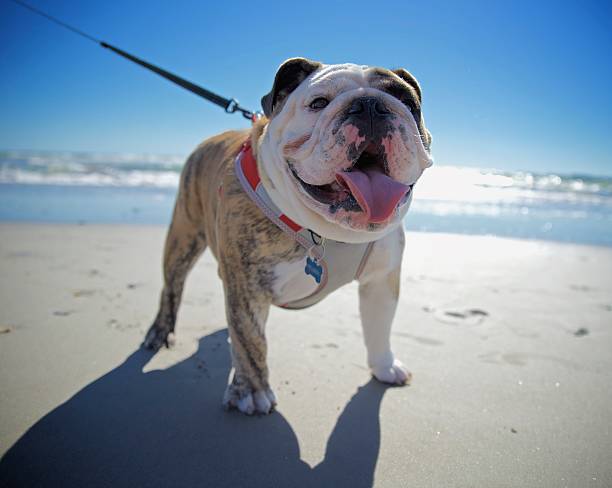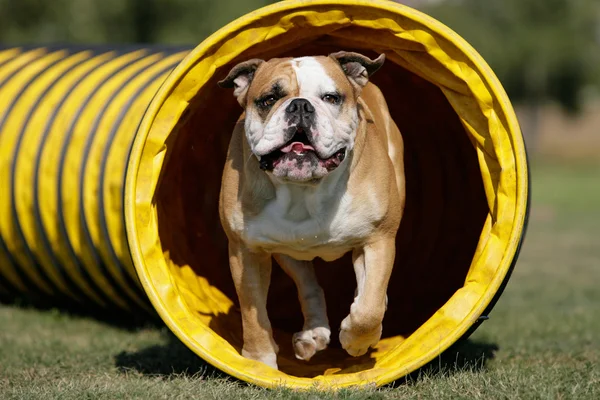The Continental Bulldog, an embodiment of charm, adaptability, and friendly disposition, resonates deeply with those who seek a loyal and versatile companion. With its distinctive appearance, friendly nature, and adaptability, this breed has carved out a treasured niche as both a beloved family member and a testament to European canine elegance.

| Category (Explanation) | Breed Information |
|---|---|
| Year of Breed Conception | Late 20th century |
| Country of Origin | Europe |
| Weight (Male) | 66-88 lbs (30-40 kg) |
| Weight (Female) | 55-77 lbs (25-35 kg) |
| Coat Type | Short, dense |
| Color Variations | Various, including brindle, fawn, and more |
| Shedding Level | Low to moderate |
| Height (cm & in) | 20-23 inches (51-58 cm) |
| Breed Size | Medium to large |
| Trainability | Moderate |
| Mental Needs | Moderate |
| Intelligence Level | Moderate |
| Energy Level | Moderate to high |
| Agility | Moderate |
| Loyalty | High |
| Playfulness | Moderate to high |
| Exercise Needs | Regular exercise and mental stimulation |
| Guarding Proficiency | Moderate |
| Sociability with Children | High |
| Barking Level | Low to moderate |
| Digging Tendency | Low to moderate |
| Destructive Behavior | Low to moderate |
| Drooling Level | Moderate to high |
| Obedience Level | Moderate |
| Apartment Friendly | Yes, with proper exercise and mental stimulation |
| Inherent Prey Drive | Moderate |
| Physical Risk to Others | Low to moderate |
| Travel Fatality Risk | Low |
| Allergen Potential | Low (considered hypoallergenic) |
| Health Concerns | Hip dysplasia, skin problems, joint issues |
| Average Life Expectancy | 10-13 years |











































































Woof Mastery is reader supported and our articles may contain affiliate links.
Instead of running third party ads that we have no control of we only use links from high-quality companies we are directly partnered with. Making use of these links come at no cost to you our reader, and in many cases have the extra benefit of discounted rates or sign up bonuses.
If you’re interested you can read more about our affiliate policy here.
We appreciate your support and always insure that the products and services we recommend are high-quality, helpful and relevant to the subject at hand!
The Continental Bulldog’s history is a tale of European heritage and careful breeding. Originating from Germany, this breed was developed in the late 20th century by crossing the Old English Bulldog and various other bulldog breeds. The goal was to create a healthier and more athletic bulldog while retaining the breed’s iconic appearance and friendly disposition.
Through meticulous breeding, the Continental Bulldog emerged as a breed that excels as a loyal family companion. Their journey from various bulldog breeds to a recognized breed in Germany showcases their adaptability and enduring spirit, embodying the values of health, intelligence, and companionship cherished by modern families.

What makes the Continental Bulldog special is its dedication to preserving the traditional bulldog qualities while promoting better health and well-being. These dogs are known for their muscular build and loyalty to their families. Continental Bulldogs balance their classic appearance with improved health, making them special to those who value both tradition and vitality.
Their traditional role was as versatile working dogs, excelling in various tasks while forming strong bonds with their families.
Continental Bulldogs are renowned for their loyal and protective personalities. They are affectionate with their families and possess an innate intelligence that makes them responsive to training.
These dogs may have an imposing presence, but they can be remarkably gentle and loving with those they care about. Continental Bulldogs have a dignified air about them, often seen as noble protectors of their home and loved ones.
They take their role as guardians seriously and will go to great lengths to ensure the safety and well-being of their family.
While they may show initial reserve with unfamiliar people, their devotion to their owners is deep and unyielding, and they are known for forming strong bonds that are unbreakable. Continental Bulldogs are a perfect example of the harmonious blend of strength and affection, embodying both the protector and the gentle companion.
Continental Bulldogs typically exhibit a friendly and loyal temperament. While they are often affectionate with their families, protective instincts may surface, requiring proper training and socialization to avoid overprotectiveness.
Territorial behavior and occasional stubbornness can be addressed through consistent and patient training methods. Leash training is essential due to their strength and size. When well-socialized, Continental Bulldogs tend to be welcoming to other dogs and people, reflecting their well-balanced and friendly nature.
They are known for their affectionate and adaptable disposition.
Continental Bulldogs are medium-sized dogs known for their compact and balanced build. They possess a square-shaped head with a broad, well-defined jaw and muscular cheeks, conveying an alert and friendly expression.
Their eyes are typically brown and round, reflecting their cheerful nature. Ears are medium-sized and set high.
These dogs feature a short, smooth coat that comes in various colors, often with a black mask. The coat accentuates their well-proportioned physique.
Continental Bulldogs boast a muscular neck, leading to a broad chest and sturdy, straight legs. The tail is typically straight.
In terms of size, males stand between 20 to 23 inches (51-58 cm) at the shoulder, while females are slightly smaller. Weight ranges from 50 to 75 pounds (23-34 kg) for males, with females being lighter.
Overall, Continental Bulldogs have an athletic and friendly appearance, reflecting their history as loyal and adaptable companions. Their appearance exudes confidence, strength, and a cheerful disposition.
Continental Bulldogs come in a range of attractive color variations that complement their strong and robust appearance. The most common color varieties for Continental Bulldogs include:
Continental Bulldogs have a moderate shedding level. They may shed year-round, with shedding intensity potentially increasing during seasonal changes. Regular grooming and brushing with a bristle brush or a deshedding tool can be beneficial in managing shedding and maintaining their coat’s quality.
Factors affecting shedding in Continental Bulldogs include genetics, age, and skin care. Properly managing skin health and addressing any dermatological issues can help minimize shedding. Regular veterinary check-ups can address underlying health concerns that may contribute to shedding.
Continental Bulldogs, a delightful mix of elegance and sturdiness, prides themselves on their short yet dense coat.
Brushing: Their coat, reminiscent of their Bulldog ancestors, can be deceptive in its density. A deep brushing session weekly, utilizing both a rubber mitt and a medium-bristle brush, helps stimulate the skin, manage shedding, and ensure overall coat health. It’s also a bonding time, allowing pet owners to spot any abnormalities or skin issues early on.
Bathing: Their somewhat sensitive skin requires extra attention. Bathing every 4-5 weeks with hypoallergenic or oatmeal-based shampoos can be beneficial. Post-bath, a gentle dog-friendly conditioner can help in maintaining the coat’s sheen and softness.
Ears: Their ears, semi-floppy in nature, have the unique potential to trap moisture, debris, and dirt. Bi-weekly cleaning with a vet-recommended solution is essential, along with daily checks to ensure no foul odor or redness is present.
Nails: Overgrown nails can alter their gait and cause pain. A bi-weekly routine, combined with occasional filing, will keep their paws healthy.
Teeth: The Continental’s jaw structure makes them slightly more susceptible to dental issues. Hence, apart from the traditional brushing regime, introducing dental diets or special kibbles can further safeguard their oral health.
Wrinkle Care: Their delightful face wrinkles, albeit lesser than their ancestors, can be a breeding ground for bacteria if left moist. Daily cleaning, especially after meals, followed by gentle drying, is crucial.
Eye Care: The breed’s eyes, bright and often reflecting their mood, are a window to their well-being. Daily checks for any unusual discharge, redness, or cloudiness can be vital.
Continental Bulldogs have a moderate activity level. They are known for their loving and gentle nature. Here are some key points to consider about their activity level:
The Continental Bulldog showcases a moderate level of intelligence, characterized by adaptability, problem-solving skills, and a strong desire to please their owners. Here are some key points about their intelligence:
The Continental Bulldog may not be as widely recognized as some other breeds, but their intelligence is evident in their adaptability, problem-solving skills, and loyalty. They make excellent companions and watchdogs. Training, socialization, and mental stimulation are essential to help them reach their full potential.
Continental Bulldogs have an active mind. Tasks that require problem-solving, such as intelligence toys or search games, are right up their alley.
Social Interaction: Their affable nature necessitates consistent bonding moments with their human family. Extended periods of solitude can breed anxiety.
Exercise: Engaging in regular physical activities not only maintains their physique but also ensures their mental equilibrium. Simple fetch games or walks can be invigorating.
Training and Obedience: With their eager-to-please demeanor, Continental Bulldogs thrive under structured training that mentally challenges and reinforces their bond with their owners. Positive reinforcement is the key.
Routine and Structure: Predictable daily rhythms provide them with a sense of assurance, making them feel anchored and content.
Affection and Attention: These Bulldogs love being the center of attention. Cuddle sessions and quality time are integral to their emotional well-being.
Socialization: Early interactions with diverse environments and beings mold them into sociable and adaptable adults.
Safe Environment: Crafting a cozy and safe nook for them at home is vital. It’s their go-to spot for relaxation and introspection.
Consistency: A stable approach in training and daily life routines boosts their confidence and understanding of their surroundings.
Enter The Woof Mastery

Before welcoming a Continental Bulldog into your home, it’s important to understand their specific needs. These dogs are known for their friendly and adaptable nature. They require regular exercise and mental stimulation to thrive. Training and socialization are essential to ensure they are well-behaved.
Be prepared for potential health concerns specific to the breed, including hip dysplasia. Grooming needs are relatively low. Responsible ownership involves providing a loving and secure environment for these loyal and versatile companions.
Continental Bulldogs, developed as a healthier alternative to the English Bulldog, have the potential to pose a physical danger if they aren’t appropriately socialized, trained, or managed. Behavior is affected by factors such as temperament, upbringing, training, and owner involvement. Here’s their potential danger assessment:
Continental Bulldogs are renowned for their loyal and protective personalities. They are affectionate with their families and possess an innate intelligence that makes them responsive to training.
These dogs may have an imposing presence, but they can be remarkably gentle and loving with those they care about. Continental Bulldogs have a dignified air about them, often seen as noble protectors of their home and loved ones. They take their role as guardians seriously and will go to great lengths to ensure the safety and well-being of their family.
While they may show initial reserve with unfamiliar people, their devotion to their owners is deep and unyielding, and they are known for forming strong bonds that are unbreakable. Continental Bulldogs are a perfect example of the harmonious blend of strength and affection, embodying both the protector and the gentle companion.
Continental Bulldogs, a relatively newer breed with origins in Switzerland, possess specific attributes related to their swimming capabilities. Here are the factors to consider:
While some Continental Bulldogs might find the water appealing and manage short swims, it’s crucial to gauge their comfort and ensure safety during any aquatic interaction.
Continental Bulldogs have their own set of vocalizations that they use for communication. Here’s a breakdown of the sounds they might produce.
For Continental Bulldog owners, understanding their pet’s vocalizations and their reasons is key. While many of these sounds are expressions of their personality, others might hint at discomfort or specific needs. Positive reinforcement techniques can be valuable in navigating their vocal habits.
Continental Bulldogs thrive in homes where they receive love, structure, and opportunities for socialization. Here are some ideal living conditions for Continental Bulldogs:
Challenges:
When it comes to travel fatality risk for Continental Bulldogs, consider the following potential constraints:
By being aware of these specific issues and taking appropriate measures, you can ensure a comfortable and safe voyage for your Continental Bulldog, decreasing potential travel hazards.
Continental Bulldogs may be prone to specific health concerns. While not all individuals will experience these issues, it’s essential for Continental Bulldog owners to be aware of potential health problems and work with veterinarians to maintain their pets’ well-being. Common health concerns in Continental Bulldogs include:
Regular veterinary check-ups, a balanced diet, proper exercise, and responsible breeding practices can help mitigate some of these health concerns. It’s crucial for Continental Bulldog owners to work closely with their veterinarians to monitor their pets’ health and address any issues promptly.
To ensure the health and vitality of Continental Bulldogs, also known as Continental Bulldogs, it’s crucial to adhere to these specialized nutritional habits and best practices:
Breed-Specific Laws (BSL): Continental Bulldogs may sporadically be affected by breed-specific laws (BSL) in select regions. Such laws can vary greatly and are generally enacted at the municipal or local level.
Types of Restrictions: Under BSL, Continental Bulldogs might face regulations like mandatory spaying/neutering, unique licensing, liability insurance requirements, muzzling in public areas, and in some situations, prohibitions on ownership, all depending on the local ordinance.
Rationale for BSL: BSL usually originates from concerns about certain breeds and their potential risks, particularly if there have been related incidents. Continental Bulldogs, though bred for a balanced temperament, can occasionally be subject to these laws due to their bulldog lineage.
Controversy: The issue of BSL is a point of contention, with critics suggesting that laws should be based on individual dog behavior rather than breed. Advocates often push for a focus on responsible dog ownership and training.
Local Regulations: For those considering owning a Continental Bulldog, it’s essential to be aware of any local breed regulations and consult local animal control or governing bodies.
Woof Mastery is reader supported and our articles may contain affiliate links.
Instead of running third party ads that we have no control of we only use links from high-quality companies we are directly partnered with. Making use of these links come at no cost to you our reader, and in many cases have the extra benefit of discounted rates or sign up bonuses.
If you’re interested you can read more about our affiliate policy here.
We appreciate your support and always insure that the products and services we recommend are high-quality, helpful and relevant to the subject at hand!
Myth 1: Continental Bulldogs are Aggressive by Nature
Myth 2: They are High-Energy Dogs
Myth 3: They Can’t Tolerate Cold Weather
Myth 4: They are Not Good with Children
Myth 5: They Shed Excessively
Myth 6: They Don’t Require Training
Myth 7: They are Always Good with Other Dogs
Myth 8: They Are All the Same Size
Myth 9: They are Unhealthy Dogs
Myth 10: They are Always Clingy
The Continental Bulldog holds cultural significance in various contexts:
While there may not be as many famous Continental Bulldog owners as there are for other dog breeds, here are a few notable individuals who have been associated with Continental Bulldogs:
Continental Bulldogs, like many other dog breeds, have faced several threats and challenges over the years. Some of the significant threats and issues that have affected the breed include:
The Continental Bulldog is believed to have been developed from a combination of various breeds, with the primary ancestors being the English Bulldog and Olde English Bulldogge. The breed’s development took place in Switzerland, aiming for a healthier, more agile bulldog. The specific breeds and strains that contributed to the Continental Bulldog’s development include:
Continental Bulldogs are a harmonious blend of athleticism and charm, epitomizing the spirit of cherished family pets. With their striking appearance and loving nature, they seamlessly integrate into our lives, providing not only security but also heartfelt devotion.
These dogs excel as watchdogs, displaying protective instincts that solidify their role as guardians of our homes. Continental Bulldogs are known for their adaptability, thriving in various living conditions, and requiring only minimal grooming. Their athletic prowess caters to active individuals and families, making them excellent playmates. Their intelligence shines in various activities and training.
Beyond their physical attributes, Continental Bulldogs bring a unique charm to every household, filling the air with their presence. Their versatility is a testament to their adaptability, transitioning effortlessly from beloved family pets to diligent working dogs.
Most importantly, Continental Bulldogs offer an unparalleled gift—profound and unconditional love. They become treasured family members, enriching our lives with their unwavering companionship and forging an unbreakable bond that lasts a lifetime. Embrace the incredible love and devotion that Continental Bulldogs have to share.